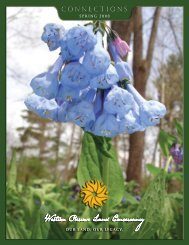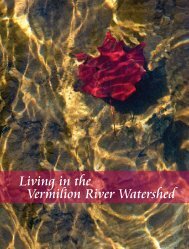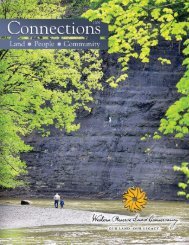Common Ground - Western Reserve Land Conservancy
Common Ground - Western Reserve Land Conservancy
Common Ground - Western Reserve Land Conservancy
You also want an ePaper? Increase the reach of your titles
YUMPU automatically turns print PDFs into web optimized ePapers that Google loves.
24 CHAPTER 3 HOW AND WHY LAND IS PRESERVED<br />
Protected land is key for native brook trout<br />
In 1972, Dr. Andrew White of<br />
John Carroll University found two<br />
reproducing populations of native brook<br />
trout in the headwaters of the Chagrin<br />
River in Geauga County.<br />
At the time, it was believed that all of<br />
Ohio’s native brook trout – fish that<br />
can survive in only the coldest and<br />
cleanest water – had died off due to<br />
pollution and development.<br />
Subsequent DNA testing confirmed that<br />
these fish were the remnants of the<br />
original brook trout that lived in Ohio’s<br />
streams and rivers after the glaciers<br />
retreated some 10,000 years ago.<br />
State and local researchers wondered:<br />
Could there be even more?<br />
No additional populations were found<br />
when the state surveyed streams in<br />
the Chagrin, Grand and Rocky River<br />
watersheds. But the study found 15<br />
suitable sites for reintroduction of<br />
brook trout – very small, spring-fed<br />
streams that are completely forested.<br />
From 1996 to 2004, native brook trout<br />
– raised first in a private hatchery<br />
at University School and then at a<br />
state-operated one in Castalia – were<br />
reintroduced to those creeks.<br />
courtesy Ohio Division of Wildlife<br />
Ohio Division of Wildlife biologists have discovered there are seven streams in northern Ohio with<br />
reproducing populations of native brook trout, top left. The species was once believed to have<br />
died off due to pollution and development.<br />
Today, seven of the streams – six<br />
in the Chagrin River watershed in<br />
Geauga County, the other in the Rocky<br />
River watershed in Summit County –<br />
still have reproducing populations of<br />
native brook trout, according to state<br />
monitoring reports. In nearly each<br />
case, the properties containing the<br />
streams have been protected by parks,<br />
conservation easements or both.<br />
“Long term protection of these<br />
streams is really the key,” said Curtis<br />
Wagner, a program monitor and a<br />
fisheries biologist with the Ohio<br />
Division of Wildlife.<br />
The goal of the brook trout<br />
reintroduction program was to return<br />
a habitat-sensitive, native fish to its<br />
former range, not to produce a sport<br />
fishery. In fact, these trout rarely<br />
exceed 8-10 inches in length. The<br />
project has reinforced the need for<br />
collaboration and land-protection<br />
in conservation efforts; in this<br />
instance, partners included the<br />
state of Ohio, Geauga Park District,<br />
Cleveland Metroparks, the Brook<br />
Trout Advisory Committee, <strong>Western</strong><br />
<strong>Reserve</strong> <strong>Land</strong> <strong>Conservancy</strong>, University<br />
School and the Trout Club of the<br />
Cleveland Museum of Natural History.<br />
long-term programming and support for farmers and related<br />
businesses with the Wayne Economic Development Council.<br />
AMP knows that to maintain healthy farms in Ohio, we<br />
need to preserve more than just farmland. The health of the<br />
social and business agricultural communities must also be<br />
fostered. Economically healthy farms are easier to preserve<br />
and maintain in the long term.<br />
Heightened interest in local foods and urban farming has<br />
also given a boost to land conservation efforts.<br />
The local foods movement has grown quickly in northern<br />
Ohio in recent years. The website SustainLane recently<br />
ranked Cleveland as the second-best local-food city in the<br />
United States, pointing to a nearly 600% increase in the<br />
number of farmers’ markets and a “sizeable increase” in<br />
community gardens since 2006. The region’s current local<br />
food movement also in Community Supported Agriculture<br />
programs, urban farms and restaurants that use locally<br />
sourced ingredients. In the Cuyahoga Valley National Park,<br />
11 small farms have been established under a bold initiative<br />
launched by the Countryside <strong>Conservancy</strong>.<br />
The local foods trend has not gone unnoticed by the larger<br />
agricultural community. Susan Crowell, who has edited the<br />
influential Salem, Ohio-based Farm and Dairy newspaper for<br />
the past 23 years, says she has “never seen as much interest<br />
from the general consumer as to where their food comes<br />
from.”<br />
Farming has emerged as a creative solution to the problem<br />
of vacant urban land.<br />
Such farming got its start in northern Ohio after World War<br />
II, when some school yards were used to grow food for local<br />
neighborhoods. The use of the gardens dropped off over<br />
time as interest waned. But urban farming came into focus<br />
once again when the foreclosure crisis made more inner-city<br />
land available.<br />
In 2005, City Fresh and Ohio State University Extension<br />
developed an urban-market-garden training program. Urban<br />
farmers in the program began turning urban vacant land<br />
into business opportunities. By 2010, even more ambitious<br />
operations started to take root, and it became clear that<br />
urban farms were here to stay. In 2012, Cleveland’s Michael<br />
Walton became the first urban farmer to testify before the<br />
U.S. House Agriculture Committee in Washington, D.C.









